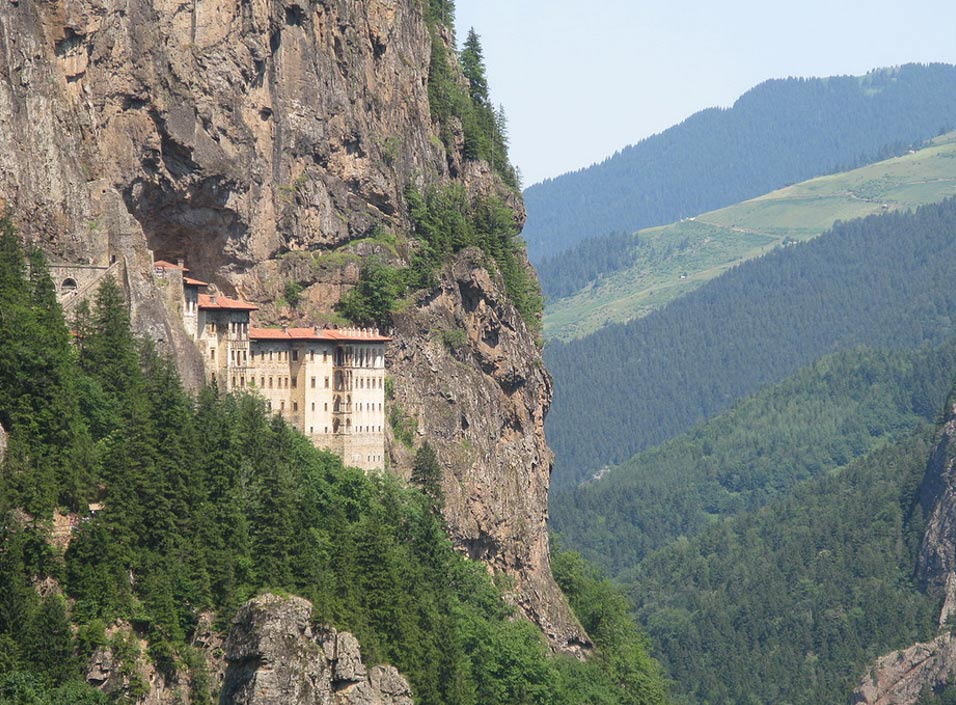The Thousand-Year History of the Spectacular Cliff Face Monastery of Sumela
The Sumela Monastery is one of the oldest and most historic monasteries in the Christian world. There are no exact records about when it was built or by who, but it is estimated that its history dates back some one thousand years and that the locals who constructed it did so to escape enemy attacks. Located high up on the steep cliffs above the surrounding forest in Trabzon, Turkey, this incredible feat of architecture has changed hands many times over the course of its existence, until it was finally abandoned in 1923.
The Sumela monastery is located outside the Turkish city of Trabzon. Standing on a steep cliff on the Zigana Mountains, it is popularly known as "Meryem Ana" (The Virgin Mary). This building complex, which is located at a height of 1,200 meters (3,937 feet), is nearly 300 meters (984ft) high and follows a tradition of monasteries that were located outside cities in forests near caves and sources of water. The road to get there is about 45 km (28 miles) from Trabzon and climbs steadily. Upon arriving at the monastery, the structure appears almost glued to the mountainside. The entrance is reached by climbing a long and narrow stairway where there is a large aqueduct at the top with many arches, which has mostly been restored.

Sumela Monastery from across the valley (Wikimedia Commons)
Features of the Sumela Monastery
The main buildings of the Monastery complex are its Rock Church, chapels, kitchens, student rooms, a guesthouse, library and a fountain used to collect spring water from the mountain, which was revered by the Greeks. A large building in which a balcony on the front part of the cliff sits was used by monks and dates back to 1860. The influence of Turkish art can also be observed in the design of the cupboards, niches and fire-places in the rooms of the buildings surrounding the courtyard.
The Rock Church of Sumela
The Rock Church at Sumela is a very strange building. It appears to be wedged into the corner of the mountain, while the apse is made of brickwork. What makes this church so unique is that the interior, as well as the exterior, is covered in frescoes. The main subject of these frescoes are biblical scenes and scenes depicting the story of Christ and the Virgin Mary. The inner and outer walls of the Rock Church, as well as the walls of the adjacent chapel, were painted on three levels in three different periods that date back to the beginning of the 15th century.

The fresco-covered rock church of Sumela (Wikimedia Commons)
Ancient origins
The Sumela monastery was founded in 386 A.D. by Greek Orthodox monks and dedicated to the Virgin Mary. Legend says that two monks from Athens, St Barnabas and his nephew St. Sophronios, saw an image of the virgin in a cave (now the Rock Church) and decided to build the monastery on that spot. However, many historians maintain that it was in existence long before this. Over the centuries, Sumela thrived and became an important location not only for monks, but for pilgrims. It took the name of "Sumela" which derives from the Greek "Melas", meaning black. Although, it is thought that it took this name from the Karadaglar (Black Mountains) on which it stands, it could also have been associated with the black color of the icon of the Virgin Mary.
Changing hands
During its long history, the monastery fell into ruin several times and was restored by various emperors. In the 6th century, it was restored by the General Belisarius, at the behest of Emperor Justinian of the Byzantine Empire, who wanted it enlarged. In the 13th century, Trabzon and the surrounding areas started to fall under control of a new formation called the Komnenos Dynasty, which developed as a separate state of the Byzantium Empire. Trabzon became their capital and the princes titled themselves as the true heirs of the Byzantium Empire. During the reign of Alexios Komnenos III (1349-1390), the monastery took its present form and its income was assured from imperial funds. In the time of Manuel III, son of Alexios III, and during the reign of later princes, Sumela would gain further wealth from new imperial grants.

The ‘backyard’ of the Sumela Monastery (Wikimedia Commons)
When the Ottomans and Sultan Mehmet II conquered Trabzon in 1461, he ordered that the Sumela monastery to be protected and the Sultans, following his order, gave special rights and privileges to the monastery. A large Greek community continued to live in the empire of Trebizond, mainly involved in trading activities. The main churches were turned into mosques and the Greeks who had maintained their Orthodox faith were obliged to meet in tiny, almost hidden churches.
Located miles away from the nearest village, the Sumela monastery was not seen by the Ottoman rulers as being in defiance of Islam, so the Greek community of Trebizond was allowed to support the monks living in the monastery.
In the 18th century, parts of the Sumela Monastery were restored and the church walls were further decorated with frescoes. Until the Russian occupancy in Trabzon (1916- 1918), the monastery stayed active and was visited by monks and the site of Christian and Muslim pilgrimages. It was during this time that the monastery took on a more impressive appearance with the addition of larger buildings.

Impressive frescoes inside the Sumela Monastery (Wikimedia Commons)
The Abandonment of Sumela
In 1923, the Ottoman Empire collapsed after the National Liberty war. That same year, the Sumela monastery was abandoned, following the forced exchange and relocation between Greeks and Turks in accordance with the Treaty of Lausanne. A transfer of population (of approximately 2,000,000 people) was agreed upon. In 1930, those who migrated founded a new monastery which they named as the new Panagia Soumela Monastery on the slopes of Mount Vermion, in Macedonia, Greece. With a fire in 1930, the wooden parts of the Sumela Monastery were destroyed and in the following years, treasure hunters would damage other parts of the monastery. Today the monastery is seldom used by monks, but has become a popular outdoor museum open to visitors around the world. The Turkish government is funding restoration work, and the monastery has enjoyed a revival in pilgrimages from Greece and Russia.
In 2017, a chapel which is only accessible through a hidden passage was discovered during restoration work at the monastery. Vibrant murals cover the walls and depict scenes of heaven and hell and life and death. It is believed that the chapel is older than the rest of the monastery and was built at a time when Christianity was not as popular in the region.
Below is a spectacular 3D virtual walkthrough of the Sumela Monastery.
Featured image: The Sumela Monastery, Turkey (Wikimedia Commons)
By Bryan Hill
References
"Sumela Monastery." Atlas Obscura. http://www.atlasobscura.com/places/sumela-monastery
"Sumela Monastery." Sumela History -. http://www.sumela.com/listingview.php?listingID=4
"Sumela Monastery." The History of the Sumela Monastery. http://www.singlix.com/karadeniz/sumela2.html
Piegsa-Quischotte, Inka. "Sumela Monastery: Turkey’s Breathtaking Treasure." Travelandescape.ca. http://www.travelandescape.ca/2013/03/sumela-monastery-turkeys-breathtaking-treasure/
"The Miraculous History of Soumela Monastery and Its Panagia Soumela Icon." Sumela Monastery History. http://panagiasumela.org/en/soumela-monastery-history_3.

















Comments
Beautiful monastery...amazing photos...Turkey is a beautiful country...
This is amazing. The architects had a perfect assumption of building the monastery on the cliff where landslide probability is very low. A masterpiece!
sww
It's a shame there's no religious freedom in Turkey. And so many churches are turned into mosques.
What a gesture it would be when the Turk authorities a.o. handed over the Hagia Sophia to the Greek Orthodox Church again.....
Too bad its like all religion; waste of time.
What a great story about early Christianity
Pages